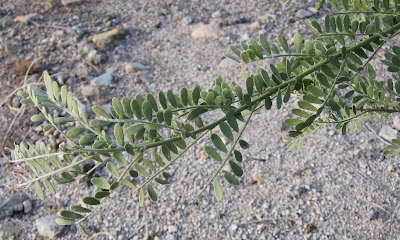The ironwood tree (Olneya tesota) is found only in the Sonoran Desert below 2,500 feet where freezing temperatures are uncommon. Its habitat is almost an identical match for the Sonoran Desert boundary.
This ironwood tree was found near the Cottonwood entrance to Joshua Tree National Park. The bajada between the I-10 freeway and the Cottonwood Mountains is the only place in that park where the ironwood tree is found. It was photographed in early April.
It has one or more trunks, can get as high as 45 feet and live as long as 800 years. It has lavender to pink flowers in May (the tree below was photographed in Organ Pipe Cactus National Monument in late May),
then by early summer has two-inch pods that mature, each containing one to eight shiny brown seeds that are eaten by many animals. It is one of the hardest and heaviest woods in the world and it is remarkably resistant to rotting.
The trunks can persist up to 1,600 years. This particular dead ironwood tree was found on the bajada below the Eagle Mountains near the Hayfield Road exit of the I-10.
It grows extremely slowly, perhaps due to low rates of photosynthesis that keep it from wasting soil moisture. These slow rates contribute to the density of its heartwood.
The leaf is doubly divided into 4 to 12 pairs of narrowly elliptic leaflets called pinnae.
Each leaf has two to four fingers with paired leaflets down the sides of each.
The leaves usually turn yellow and are shed in April before the trees flower. The flowers bloom on the end of short shoots along the branches.
The flowering period lasts only 10 to 18 days.
During long droughts, the trees slough off leaves, limbs and rootlets to reduce water needs. It creates its own micro-habitat. It serves as a perch and roost for hawks and owls.
It tempers the elements beneath it, creating a habitat with less direct sunlight, lower suface temperature (as much as 15 degrees cooler), more organic matter and higher water availability.
Its canopy is utilized by 150 bird species and 62 reptiles and 64 mammals use it for forage, cover and a birthing ground.
It fosters many young plants that grow beneath it, more than 230 species recorded, creating a wonderful forage source for rabbits, bighorn and other animals. Bighorn sheep, pronghorn antelope and mule deer eat its leaves and doves, quail and rodents eat its seeds.













You have to look beyond the surface to appreciate the many positive, interesting qualities of this tree. When it blooms it's quite beautiful. ..."Who would have known?!"
ReplyDelete